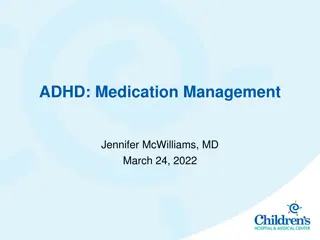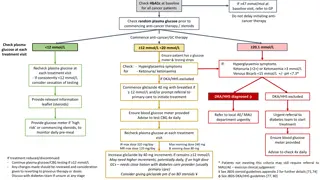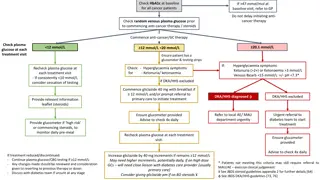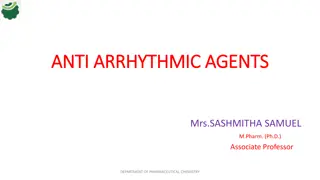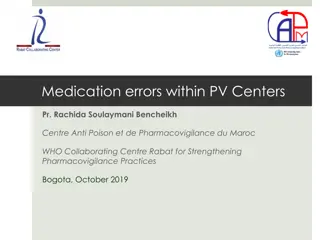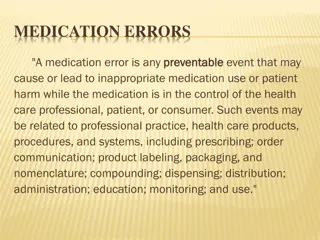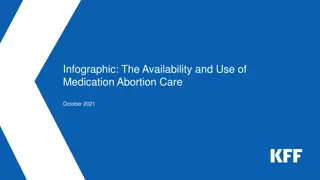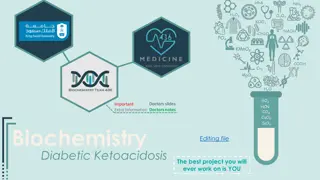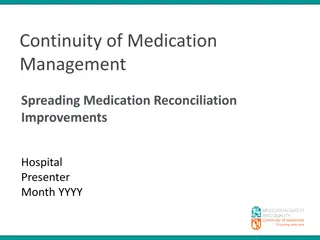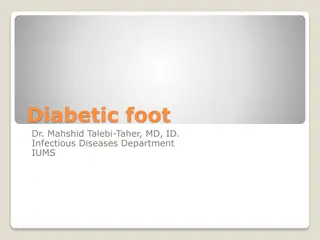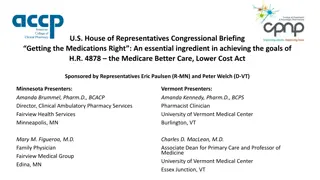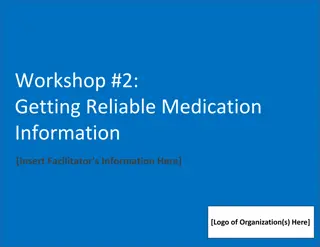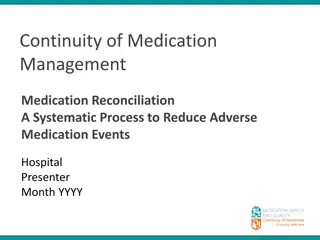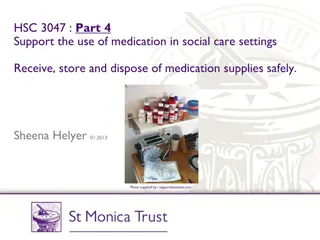Overview of Anti-Diabetic Medication and Treatment Options
Anti-diabetic medications are used to treat diabetes by lowering glucose levels in the blood. There are various classes of drugs such as insulin, sensitizers, secretagogues, and more, each targeting different aspects of diabetes management. Type 1 diabetes requires insulin injections, while Type 2 diabetes can be managed with oral hypoglycemic agents. Treatment selection depends on factors like the nature of diabetes and individual circumstances.
Download Presentation

Please find below an Image/Link to download the presentation.
The content on the website is provided AS IS for your information and personal use only. It may not be sold, licensed, or shared on other websites without obtaining consent from the author. Download presentation by click this link. If you encounter any issues during the download, it is possible that the publisher has removed the file from their server.
E N D
Presentation Transcript
Anti-diabetic medication Dr. r. Babujanarthanam, Associate Professor, Department of Biochemistry
Drugs used in diabetes treat diabetes mellitus by lowering the glucose level in the blood. With the exceptions of insulin, exenatide, liraglutide and pramlinti de, all are administered orally and are thus also called oral hypoglycemic agents or oral antihyperglycemic agents. There are different classes of anti-diabetic drugs, and their selection depends on the nature of the diabetes, age and situation of the person, as well as other factors. Diabetes mellitus type 1 is a disease caused by the lack of insulin. Insulin must be used in type 1, which must be injected. Diabetes mellitus type 2 is a disease of insulin resistance by cells. Type 2 diabetes mellitus is the most common type of diabetes. Treatments include (1) agents that increase the amount of insulin secreted by the pancreas, (2) agents that increase the sensitivity of target organs to insulin, and (3) agents that decrease the rate at which glucose is absorbed from the gastrointestinal tract. Several groups of drugs, mostly given by mouth, are effective in type 2, often in combination. The therapeutic combination in type 2 may include insulin, not necessarily because oral agents have failed completely, but in search of a desired combination of effects.
Insulin Insulin is usually given subcutaneously, either by injections or by an insulin pump. In acute-care settings, insulin may also be given intravenously. In general, there are three types of insulin, characterized by the rate which they are metabolized by the body. They are rapid acting insulins(Regular insulin (Humulin R, Novolin R); Insulin lispro (Humalog)) intermediate acting insulins (Isophane insulin, neutral protamine Hagedorn (NPH); Insulin zinc (Lente)) long acting insulins (Extended insulin zinc insulin (Ultralente); Insulin glargine (Lantus)) Sensitizers Insulin sensitizers address the core problem in type 2 diabetes insulin resistance. Biguanides Biguanides reduce hepatic glucose output and increase uptake of glucose by the periphery, including skeletal muscle. Although it must be used with caution in patients with impaired liver or kidney function, metformin, a biguanide, has become the most commonly used agent for type 2 diabetes in children and teenagers. Among common diabetic drugs, metformin is the only widely used oral drug that does not cause weight gain. Thiazolidinediones Thiazolidinediones (TZDs), also known as "glitazones," bind to PPAR , a type of nuclear regulatory protein involved in transcription of genes regulating glucose and fat metabolism. These PPARs act on peroxysome proliferator responsive elements (PPRE).[7]The PPREs influence insulin-sensitive genes, which enhance production of mRNAs of insulin-dependent enzymes. The final result is better use of glucose by the cells.
Secretagogues are drugs that increase insulin output from the pancreas. Sulfonylureas were the first widely used oral anti-hyperglycemic medications. They are insulin secretagogues, triggering insulin release by inhibiting the KATPchannel of the pancreatic beta cells. The "second-generation" drugs are now more commonly used. They are more effective than first- generation drugs and have fewer side-effects. All may cause weight gain. Sulfonylureas bind strongly to plasma proteins. Sulfonylureas are useful only in type 2 diabetes, as they work by stimulating endogenous release of insulin. They work best with patients over 40 years old who have had diabetes mellitus for under ten years. They cannot be used with type 1 diabetes, or diabetes of pregnancy. They can be safely used with metformin or glitazones. The primary side-effect is hypoglycemia. Non-sulfonylurea secretagogues Meglitinides help the pancreas produce insulin and are often called "short-acting secretagogues." They act on the same potassium channels as sulfonylureas, but at a different binding site.[18]By closing the potassium channels of the pancreatic beta cells, they open the calcium channels, thereby enhancing insulin secretion.[19] Alpha-glucosidase inhibitors are "diabetes pills" but not technically hypoglycemic agents because they do not have a direct effect on insulin secretion or sensitivity. These agents slow the digestion of starch in the small intestine, so that glucose from the starch of a meal enters the bloodstream more slowly, and can be matched more effectively by an impaired insulin response or sensitivity. These agents are effective by themselves only in the earliest stages of impaired glucose tolerance, but can be helpful in combination with other agents in type 2 diabetes.
Glycosurics SGLT-2 inhibitors block the re-uptake of glucose in the renal tubules, promoting loss of glucose in the urine. This causes both mild weight loss, and a mild reduction in blood sugar levels with little risk of hypoglycemia.[35]Oral preparations may be available alone or in combination with other agents.[36] The side effects of SGLT-2 inhibitors are derived directly from their mechanism of action; these include an increased risk of: ketoacidosis, urinary tract infections, candidal vulvovaginitis, and hypoglycemia.[37] Generic Many anti-diabetes drugs are available as generics. These include:[40] Sulfonylureas glimepiride, glipizide, glyburide Biguanides metformin Thiazolidinediones (Tzd) pioglitazone, Actos generic Alpha-glucosidase inhibitors Acarbose Meglitinides nateglinide Combination of sulfonylureas plus metformin known by generic names of the two drugs





